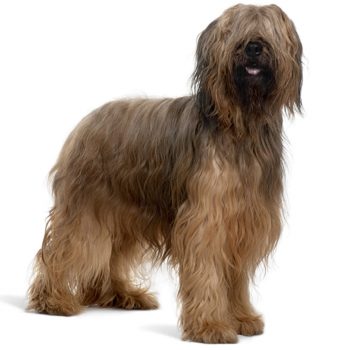Briard
Group 5: Working
Height:
Male: 61 – 69 cm
Female: 58 – 65 cm
Energy Level: Moderate
Original Function: Herding
Lifespan: 10 – 12 yrs
Recommended for: Working homes, active people & families.
Note: Not that many in Australia.

Group 5: Working
Height:
Male: 61 – 69 cm
Female: 58 – 65 cm
Energy Level: Moderate
Original Function: Herding
Lifespan: 10 – 12 yrs
Recommended for: Working homes, active people & families.
Note: Not that many in Australia.

The Briard’s lineage goes back more than 1000 years. In its native country of France it was regarded as a shepherd dog. In early days when poachers and wolves were a problem, these dogs were of great value to the local people. Later they were used to herd sheep and cattle and also they served mankind in war to carry supplies, which resulted in a great reduction of their numbers afterwards. Police also used them.
They are a good natured dog and very affectionate. They make excellent playmates for children, so are great as the family pet. They do tend to bond more closely with one family member and have been known to protect the children from parental correction! They are tough, alert and brave dogs and can be slightly aggressive with other dogs if not handled correctly. They will accept other household pets if introduced properly. They are happiest in the home as part of the family and will regard strangers suspiciously.
Appearance: Briards are sizeable (but not heavyweight), handsome dogs with attractive, distinctive long coats. They are muscular, rugged and well-proportioned. Their muscular necks carry their heads with pride. In spite of all the hair they have around their eyes, they are very keen sighted! They move effortlessly and cover the ground well. They are very supple and can turn quickly.
Temperament: Fearless, with no trace of timidity or aggressiveness.
Characteristics: Very intelligent, gay and lively.
Colour: All black, or with white hairs scattered through black coat. Fawn in all its shades, darker shades preferred. Fawns may have dark shadings on ears, muzzle, back and tail, but these shadings must blend gradually into rest of coat since any demarcation line denotes a bicolour which is not permissible. May also be slate grey.
Coat: Long not less than 7 cm on body. Slightly wavy and very dry. A fine dense undercoat required all over body. Head carries hair forming a moustache, beard and eyebrows, lightly veiling eyes.
Grooming: Grooming demands are considerable although no specialised groomers are necessary. Plenty of brushing and combing of their coarse double coats is required to help limit shedding, to prevent matting and to keep the coat clean and tangle-free.
Line-brushing (the technique of brushing upwards layer by layer) down to the skin is recommended as this will assist in the prevention of dermatitis and other skin problems. The inside of the ears must be kept clean and any excessive hair removed. Likewise the excess hair between the pads of their feet must be trimmed regularly.
Exercise: plenty of vigorous exercise is needed, they are a working dog and the mind needs to be occupied so they don’t become bored and destructive.
Health: A fairly sound breed but some can have hip dysplasia and eye problems.